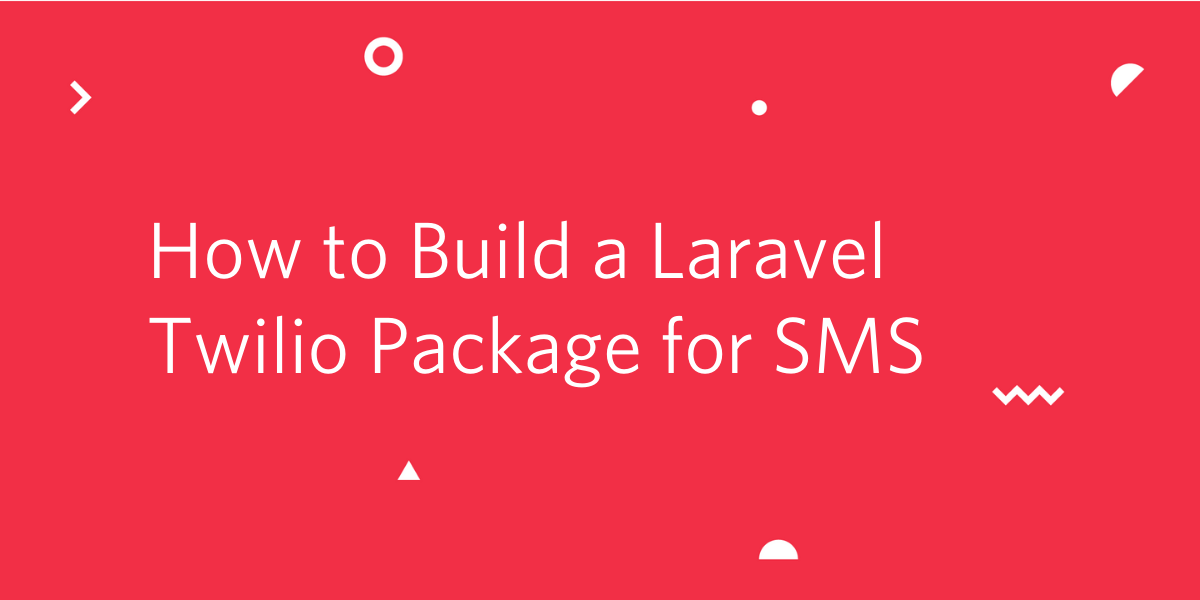How to build a Laravel Twilio Package for SMS
Time to read:

I recently realized that every time I had to do an integration with Twilio for sending SMS in a Laravel project, I used a custom wrapper around the Twilio PHP library to help me simplify the process. However, this became a bit monotonous for me as I always had to copy and paste this wrapper every time I was starting a new Laravel project. In this tutorial, you’ll join me in learning how to build a Laravel Twilio Package to eliminate copying and pasting and benefit from package management. This will also allow other developers such as yourself to make use of this package.
Technical Requirements
To complete this tutorial, you will need the following:
Setting up a New Package
We’ll be using Composer to set up the package. From the terminal, cd into your project’s directory and run the following command:
This will prompt you to pick a name for the package you’re creating. It is important to note that Composer has a recommended way for naming packages.
I’ve decided to name this package LaraTwilio, so for me the package name will be dotunj/laratwilio. Once you’ve picked a name for your package, Composer will ask you further questions of which the default options will suffice. Once you’re done, a composer.json file will be generated for you in the root of your project’s directory.
Tip: You can read more about naming packages here.
Autoloading
When it comes to autoloading in Laravel packages, psr-4 is the recommended standard. With psr-4 we simply map a namespace to a file path relative to our package root. Add the following code to the composer.json file:
Here, we’ve defined a namespace similar to that of the package’s name and mapped it to a src directory which we’ll be creating shortly.
NOTE: You will need to replace the package name “Dotun\\LaraTwilio” with your own.
Config File
We need a way to ensure users of our package provide us with their Twilio credentials as this is needed to process API requests. In the root of your project’s directory, run the following command:
This will create a config directory with a laratwilio.php file in it. Add the following code to the file we just created:
Here we’ve simply defined an array with the necessary keys mapped to their respective Twilio credentials. These values will usually be read from the application’s .env file where our package has been installed.
Installing Twilio PHP
Since our package is simply a wrapper around the Twilio PHP SDK Library, we’ll need to add it as a dependency to our package. Run the following command to install the library:
Creating the LaraTwilio Class
In the root of your project directory, create a src directory and within the directory, create a LaraTwilio.php file. This class will serve as the public API for our package. Add the following code to the file:
Using dependency injection via the constructor, we assign the Twilio Rest Client to the client property of the class. For this example, the notify() method will handle sending outbound SMS notifications using the Twilio API. It accepts two arguments, the phone number that should receive the SMS and the message itself.
LaraTwilio Service Provider
Service Providers serve as the connection point between your package and Laravel. They are responsible for binding things into Laravel’s service container and informing Laravel how to load package resources, such as config files.
In the src directory, create a LaraTwilioServiceProvider.php file and add the following code to the file:
Service providers always extend the base Illuminate\Support\ServiceProvider class and usually implement two methods register() and boot().
- In the
register()method, we call themergeConfigFrom()method Laravel provides which allows us to merge our config file with the application’s config file. Next, we register a binding into the service container such that theLaraTwilioclass we created earlier gets a configured Twilio Rest Client injected via its constructor. - The
boot()method is used to publish the package’s config file. - The
ensureConfigValuesAreSet()method is used to ensure that all the keys we defined in the config file have an associated value.
LaraTwilio Facade
In Laravel, Facades typically provide access to a class available in the service container. They usually extend the base Facade class and always return a service container binding. In the src directory, run the following command:
This will create a LaraTwilio.php file in the Facades folder. Edit the file with the following code:
Here, the getFacadeAccessor() method returns the string laratwilio which is the name of the service container binding we created in the service provider file.
Package Discovery
To ensure that Laravel will automatically register our facades and service provider whenever the package is installed, we need to configure our package for discovery. To do that, we need to define the provider and facade in the extra section of our composer.json file. Head over to the composer.json file and add the extra section as follows:
Conclusion
Packages can serve as a great way of providing code reusability and help us to follow the Don’t Repeat Yourself (DRY) principle which is the issue I had in my case. In this tutorial, we’ve seen how we can build a Twilio package intended specifically for use with Laravel. The code, as well as installation instructions, can be found on Github.
Dotun Jolaoso
Website: https://dotunj.dev/
Github: https://github.com/Dotunj
Twitter: https://twitter.com/Dotunj_
Related Posts
Related Resources
Twilio Docs
From APIs to SDKs to sample apps
API reference documentation, SDKs, helper libraries, quickstarts, and tutorials for your language and platform.
Resource Center
The latest ebooks, industry reports, and webinars
Learn from customer engagement experts to improve your own communication.
Ahoy
Twilio's developer community hub
Best practices, code samples, and inspiration to build communications and digital engagement experiences.


